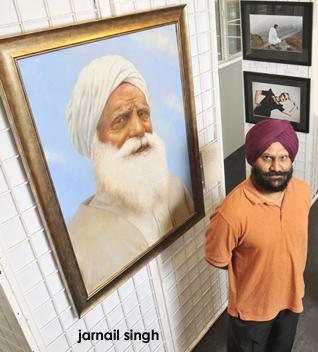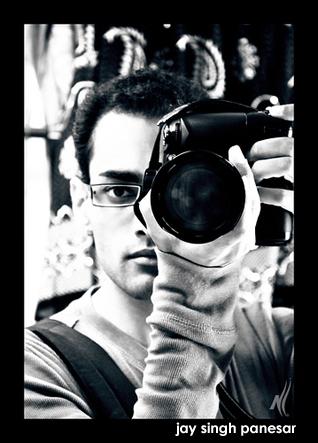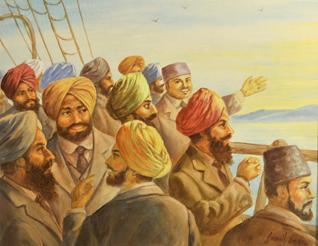Art
Father and Son: Two Art Forms
by MARIA SPITALE-LEISK
There is a great divide at a local father-and-son Sikh art exhibit on now in Surrey, British Columbia, Canada.
It is glaring the moment you step into the intimate art space at the Newton Cultural Centre.
One side of the room holds an eclectic collection of photographs - edgy fashion portraits and snapshots of avant-garde Vancouver architecture.
On the other side is a series of oil paintings depicting human emotion from Sikhs during a racially charged incident in Vancouver 1914.
Local celebrated artist Jarnail Singh has captured the pain of discrimination and deadly cabin fever with his paint brush.
Stories from the Komagata Maru come alive in the room as visitors walk past each realistic painting and accompanying fictional storyline that highlights crucial segments of a two-month ordeal.
On May 23, 1914, the Komagata Maru - a ship normally used for transporting coal - arrived in Vancouver from Hong Kong and anchored in Burrard Inlet. She carried 376 passengers, mostly Sikhs.
For this scene, Jarnail Singh has painted the Sikh men excitedly standing at the edge of the ship, their sights set on new adventures in the fast-approaching Vancouver port. It’s a colourful sea of turbans on well-dressed men in suits. One man appears to be happily praying, his fingers intertwined; another is smiling as he points towards shore.
“Look at these men, they are so happy,” explains Jarnail Singh, gesturing towards the painting. “They have no idea what is in store for them.”
Ajmer Singh Rode, an award-winning Canadian author, offers some insight. The narrative beside the painting reads First Morning in Vancouver.
Ajmer Singh writes: “The Komagata Maru stands in Vancouver’s Burrard Inlet, yards away from the shore. Its passengers and their leader, Gurdit Singh, are full of optimism. Gurdit walks to the cabin of his secretary sitting quietly in his chair.”
“Daljit Singh, go outside, join them.”
“Join who, sir?”
“The passengers. Haven’t you seen them dancing, they see the boats coming. Soon they’ll start disembarking. Soon they’ll disperse in the city. Go join them for the last time.”
“But, sir, have you seen the boats carefully?”
“Carefully? What about them?”
“We are surrounded by gun boats.”
“Are you joking, Daljit Singh?”
“I wish I were.”
Vancouver immigration officials had received word that the Komagata Maru’s passengers would not be able to cover the $15,000 charter cost [which had been precipitously imposed on them as a ruse for refusing them entry]. When the passengers sought provisions because of the unexpected delay, Canadian officials sent them a threatening message ordering a navy cruiser to pull up alongside the ship with its guns exposed. Many of the passengers, including children, went without food and water for days.
Jarnail Singh points to another one of his paintings. A mother, her head covered with a chunni, keeps vigil at her seriously ill daughter’s bedside.
Ajmer Singh writes: “... here we are dying of thirst in a British country where they say milk flows in the rivers. And look at this child - hungry, thirsty, sick. Not a pinch of water, not a bit of bread.”
The passengers’ case was eventually heard in the B.C. Court of Appeal, after the local Sikh community scrambled to cover the cost of the charter - and did raise the oppressive amount. Ultimately, it was a hastily enacted law that allowed the immigration officers to refuse entry to anyone who did not arrive directly from their country of origin - that is, without touching land en route.
After being docked off the shore of Vancouver for two months, the Komagata Maru was forced to turn around just before sunrise on July 23, 1914.
Seated at a table in the middle of the room - between both exhibits - a bespectacled 24-year-old Jay Singh Panesar sees the emotional value in his dad’s art.
The Komagata Maru incident was glossed over in his high school social study lessons, he says. Seeing the paintings and hearing the stories has opened his eyes.
“We have definitely come a long way in terms of discrimination since then,” he asserts.
Jarnail Singh stands behind his son and offers some poetic advice.
“When you know your history, you feel a sense of belonging,” says Jarnail Singh.
Jay Singh is a third generation artist. His grandfather, Kirpal Singh, was the famous Sikh painter who resurrected epic scenes from Sikh and Punjab history through his paintings - which adorn the Sikh Museum in Amritsar and many a collection around the world..
Then there are Jay’s parents - Jarnail Singh and Baljit Kaur - both extremely talented oil painters and founders of the Jarnail Arts Studio in Newton.
Jay initially took after his parents’ passion for freehand, dabbling in typical teenage boy drawings: cars, motorcycles and Japanese anime. Then like most young people his age, he sought instant gratification from art.
“I found that photography captures beauty in its natural form,” he explains.
Much of the inspiration for Jay’s photographs comes from his own life experiences.
During a trip to India in 2009, an elderly man’s pensive moment was caught through his lens. He also snapped one face of the Taj Mahal, pointing his camera skywards. Without the iconic domes in the background, the intricate detail of the outside walls is striking.
Komagata Maru Stories - a joint project between artist Jarnail Singh and author Ajmer Singh Rode - took five years to complete.
The exhibit was timed to commemorate this month’s anniversary of the ship’s departure from Vancouver.
When asked if people in Punjab still harbour any ill feelings towards Canadians because of the incident, Jarnail Singh shakes his head and softly and confidently says no.
“Those were the policies of previous governments,” he says.
There is a permanent memorial in Calcutta, India, where the ship landed after being turned away from Vancouver - and its returning unarmed passengers were shot at by British troops as the former embarked, killing dozens of them.
And last December, Canada announced plans to fund a permanent monument in Vancouver.
A delayed visa was the only hiccup that Jarnail Singh experienced during his first visit to Canada in 1995 from Chandigarh, the capital of the Punjab. He originally wanted to see the splendour that Vancouver holds in the height of summer, pleasant temperatures included.
“I ended up arriving in Edmonton, in October,” says Jarnail Singh, with a smile. “It wasn’t a culture shock, it was a climate shock. It was cold.”
He eventually immigrated to Vancouver in 2000 and says the entire process was fairly easy. He had a lot of clients here who supported him and bought his art.
His current exhibit is part of a larger project: a coffee table-style book with brilliant replicas of his paintings alongside compelling stories of the Komagata Maru.
So far, there are scores of positive remarks for Jarnail Singh and Ajmer Singh Rode’s Komagata Maru Stories and Jay Singh's Through My Lens exhibits, which run concurrently until July 30.
“Thank you for this display - powerful images of a shameful series of decisions,” reads a guestbook comment.
The Newton Cultural Centre is located at 13530 72 Ave., Surrey, British Columbia. Hours of operation are 11 am to 7 pm daily. Admission is free. For more information call 604-594-2700 or visit jarnailarts.com.
[Courtesy: Surrey Leader. Edited for sikhchic.com]
July 22, 2011
Conversation about this article
1: Harinder (Uttar Pradesh, India), July 24, 2011, 3:12 AM.
With so many talented Sikh artists in the diaspora, it is time for Sikhs to start a Sikh School of Art.





